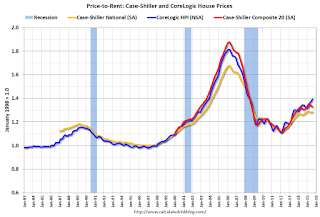Here is the earlier post on Case-Shiller:
Case-Shiller: National House Price Index increased 4.7% year-over-year in August
The year-over-year increase in prices is mostly moving sideways now at between 4% and 5%.. In October 2013, the National index was up 10.9% year-over-year (YoY). In August 2015, the index was up 4.7% YoY.
Here is the YoY change since January 2014 for the National Index:
| Month |
YoY Change |
| Jan-14 |
10.5% |
| Feb-14 |
10.1% |
| Mar-14 |
8.9% |
| Apr-14 |
7.9% |
| May-14 |
7.0% |
| Jun-14 |
6.3% |
| Jul-14 |
5.6% |
| Aug-14 |
5.1% |
| Sep-14 |
4.8% |
| Oct-14 |
4.6% |
| Nov-14 |
4.6% |
| Dec-14 |
4.5% |
| Jan-15 |
4.3% |
| Feb-15 |
4.2% |
| Mar-15 |
4.3% |
| Apr-15 |
4.3% |
| May-15 |
4.4% |
| Jun-15 |
4.5% |
| Jul-15 |
4.6% |
| Aug-15 |
4.7% |
Most of the slowdown on a YoY basis is now behind us. This slowdown in price increases this year was expected by several key analysts, and I think it is good news for housing and the economy.
In the
earlier post, I graphed nominal house prices, but it is also important to look at prices in real terms (inflation adjusted). Case-Shiller, CoreLogic and others report nominal house prices. As an example, if a house price was $200,000 in January 2000, the price would be close to $276,000 today adjusted for inflation (38%). That is why the second graph below is important - this shows "real" prices (adjusted for inflation).
It has been almost ten years since the bubble peak. In the Case-Shiller release this morning, the National Index was reported as being 6.7% below the bubble peak.
However, in real terms, the National index is still about 20.6% below the bubble peak.
Nominal House Prices

The first graph shows the monthly Case-Shiller National Index SA, the monthly Case-Shiller Composite 20 SA, and the CoreLogic House Price Indexes (through August) in nominal terms as reported.
In nominal terms, the Case-Shiller National index (SA) is back to July 2005 levels, and the Case-Shiller Composite 20 Index (SA) is back to January 2005 levels, and the CoreLogic index (NSA) is back to July 2005.
Real House Prices

The second graph shows the same three indexes in real terms (adjusted for inflation using CPI less Shelter). Note: some people use other inflation measures to adjust for real prices.
In real terms, the National index is back to July 2003 levels, the Composite 20 index is back to April 2003, and the CoreLogic index back to January 2004.
In real terms, house prices are back to 2003 levels.
Note: CPI less Shelter is down 1.1% year-over-year, so this is pushing up real prices.
Price-to-Rent
In October 2004, Fed economist John Krainer and researcher Chishen Wei wrote a Fed letter on price to rent ratios:
House Prices and Fundamental Value. Kainer and Wei presented a price-to-rent ratio using the OFHEO house price index and the Owners' Equivalent Rent (OER) from the BLS.

Here is a similar graph using the Case-Shiller National, Composite 20 and CoreLogic House Price Indexes.
This graph shows the price to rent ratio (January 1998 = 1.0).
On a price-to-rent basis, the Case-Shiller National index is back to May 2003 levels, the Composite 20 index is back to December 2002 levels, and the CoreLogic index is back to November 2003.
In real terms, and as a price-to-rent ratio, prices are back to 2003 levels - and the price-to-rent ratio maybe moving a little sideways now.

from Calculated Risk http://ift.tt/1idIZzf
via
YQ Matrix

